Neela Banerjee ’86 covers energy and environmental issues for the Los Angeles Times.
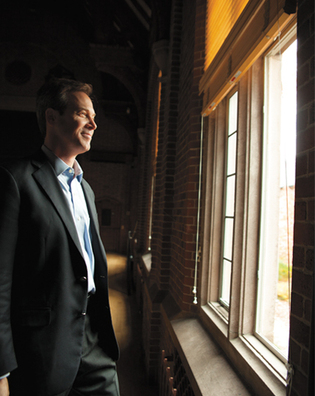
Mark Ostow
Yale professor Anthony Leiserowitz studies "human perception and human choices" about global warming. View full image
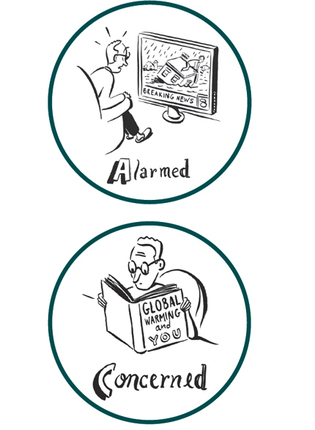
Michael Sloan
"Alarmed," "Concerned," and the drawings that follow, are the Yale Alumni Magazine's cartoons of the six groups Leiserowitz identified along the spectrum of US attitudes to climate change. View full image
What’s so funny about climate change?
Not a whole lot—judging by the comedians and writers who gathered one autumn afternoon in New York City to figure out, as one speaker put it, whether comedy has “the chutzpah to say what other media won’t” about global warming. Fake news shows and sitcoms boldly go to places that much of mainstream media avoids, sending up America’s views of politics, sex, and money. The panel, organized by the Writers Guild of America–East, aimed to help comics do the same for the upcoming UN Climate Summit. But climate change is so controversial, admitted the comedy writers on the panel, that they are as skittish about the issue as politicians running for re-election.
Sitcoms today avoid discussing real problems, said Norman Lear, creator of All in the Family. The New Yorker would rather have “insult jokes” between husbands and wives than cartoons about climate change, said cartoonist Sidney Harris. “People like to laugh at what they agree with, and they don’t like to laugh at what they don’t agree with,” said Rory Albanese, a former writer and executive producer of the Daily Show. Maybe the way to reach people on climate change, he mused, is to draw them to fake websites. “The trick has to be it can’t be associated with the left,” he said. “The website has to be, like, ‘MachineGuns.com.’”
Sitting next to Albanese and politely listening to the unanimous lament was Anthony Leiserowitz (pronounced lizer-witz), director of the Yale Project on Climate Change Communication and the only member of the panel who wasn’t part of the entertainment industry. It fell to him, in a room full of funny people, to lighten things up and breathe a little optimism into the discussion.
“The perception among many in the media, in politics, and so on—that you can’t talk about this because half the country is against you?—it’s false, it’s wrong,” Leiserowitz said, his voice rising slightly. “It’s only 15 percent. They’re a really loud 15 percent, and they have convinced much of the country it’s not safe to talk about it, but it’s just not true.”
Leiserowitz’s certainty comes from a decade’s worth of research that reveals a far more nuanced picture of American attitudes toward climate change than previously thought—or even widely held now, for that matter.
The Yale Project on Climate Change Communication digs deeply into public attitudes toward climate change, mapping the public mind and exploring why Americans think the way they do. One of the project’s most far-reaching findings: the American public is not divided evenly between those who accept climate change and those who don’t. Rather, there is a range of views that can be captured in six categories—what the Yale Project and its partner, the George Mason University Center for Climate Change Communication, call “Global Warming’s Six Americas.” According to their research, about 66 percent of Americans think global warming is happening. Only 16 percent of Americans say it is not happening, according to an October 2014 national survey.
Their findings also suggest that most Americans’ views on climate change are fluid and can be informed by certain kinds of evidence, narratives, and messengers. This idea is not without controversy: other social scientists contend that people are too locked into their tribal values to rethink their views on climate change.
Still, Leiserowitz says the project aims to shed light on “the psychological, cultural, and political factors that shape people’s understanding and handling of responses” to climate change. Already, its findings are informing the way scientists, corporations, environmentalists, and others talk about climate change and even how some policy makers frame it.
“There is no such thing as a general audience,” says Mike Casey, president of Tigercomm, a Virginia-based clean-tech marketing firm with clients such as billionaire environmental activist Tom Steyer ’79 and alternative energy companies. “The project does an important service in telling people like me what I need to know to do my work. If you go to Ohio or Florida or Virginia, and you’re going to talk about climate change, the Six Americas tells you who you are going to be talking to and who is interested in what.”
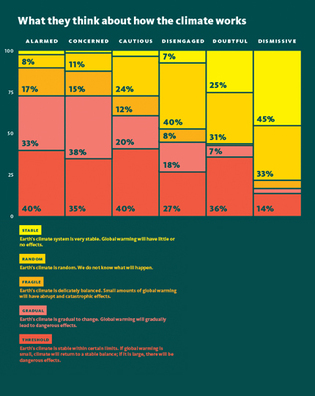
Mark Zurolo ’01MFA. Source: American's Knowledge of Climate Change (2010), by A. Leiserowitz, N. Smith, and J. R. Marlon.
In their 2010 survey, Leiserowitz and his colleague Ed Maibach probed Americans' views of how susceptible the Earth's climate is to change. Survey respondents reviewed the five descriptions shown above, which offer different models of the climate, and were asked which one best represented their own conception.
The graph above sorts the respondents' answers according to their places in the "Six Americas," the six main categories of opinion about climate change that Leiserowitz and Maibach have identified—from the "Alarmed" to the "Dismissive." Not surprisingly, those who are "Dismissive" and "Doubtful" as to whether the climate is changing are also the most likely to think that the climate is highly stable. View full image
In the last five years, scientific research has delivered more fine-grained and confident forecasts about global warming’s impact. Once considered a phenomenon that would be felt in the distant future, climate change is playing out today—intensifying extreme weather and affecting every state in the country, according to the 2014 National Climate Assessment, a sweeping report mandated by Congress and published every four years. Downpours are heavier, heat waves longer and more intense, coastal flooding more routine, and the oceans more acidic and less hospitable to many species as they absorb greater amounts of carbon dioxide.
Yet the world’s biggest polluters—China, the United States, and India—have been slow to address the problem, and last year, more heat-trapping greenhouse gases were in the atmosphere than at any other time in human history. In the United States, the dawdling has stemmed in part from the absence of a public outcry over global warming. It hasn’t helped that fossil fuel industries have funded think tanks and a handful of outspoken scientists who have successfully sown doubt among the public about the science, similar to the campaign waged decades earlier against tobacco warnings.
In terms of public opinion and action, says Leiserowitz, global warming is “a public policy problem from hell. You almost couldn’t find a problem that is a worse fit for our underlying psychology, politics, and culture.” Climate change is caused by invisible pollutants, making it harder for people to understand than oil slicks or smog. Its effects can be diffuse: scientists can show that a particular chemical plant polluted the groundwater in a given area, but they cannot say that a killer storm was caused solely by climate change—just that a hotter atmosphere worsens, and worsens the odds of, extreme weather. Finally, cutting greenhouse gases enough to avert the worst effects of climate change in the future requires collective action, such as a domestic carbon tax and international cooperation. But many in the United States bridle at the notion of new taxes and multilateral agreements.
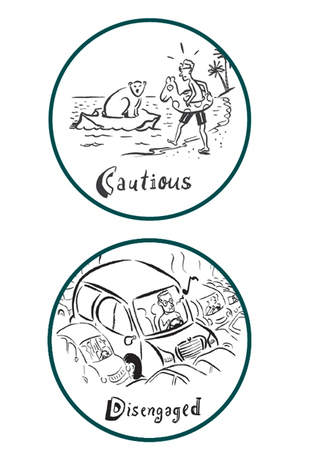
Michael Sloan
View full image
Leiserowitz has made it his work to explore, in depth, Americans’ views of the “public policy problem from hell.” “His work was groundbreaking,” says Ed Maibach, director of the George Mason Center for Climate Change Communication. Eight years ago, when Maibach first read Leiserowitz’s research, Leiserowitz “had already been thinking a long time about why Americans weren’t concerned about this enormous, if not existential, threat.”
Leiserowitz grew up on a 79-acre farm in south-central Michigan. His parents are well-known Midwestern sculptors, and his father taught at Michigan State University in East Lansing, where Leiserowitz got his undergraduate degree. After college, Leiserowitz followed a friend to Aspen, Colorado. He planned to be a ski bum, earn money, and travel the world; instead, he took a job at the Aspen Global Change Institute in the early 1990s, organizing major international conferences attended by top climatologists. As he learned more of the science of climate change from the researchers he met, he felt a growing frustration that the root cause—human activity—was not being adequately addressed.
The epiphany came one evening when he hiked up to a pass in the Colorado mountains. “I was looking west, and there was this blanket of tiny white tundra flowers,” he remembers, speaking in his office up in the eaves of a Yale environment school building. “The tundra had retreated as the world emerged from the last ice age, from the valley below to just the tops of our mountains. But I started to think about what else could be made to retreat now, like island countries that could disappear into the ocean as sea levels rise. And as the world warms, the tundra zone I was looking at could get pushed off the mountaintops.” The moment made him feel the urgency of the climate change problem. “The reason we have this problem,” he says, “is because of human perception and human choices. What is it that causes us to perceive and act toward the natural world as we do? Because the solutions to climate change rest with us.”
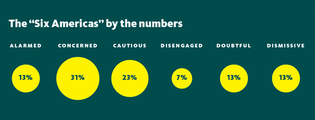
Chart: Mark Zurolo ’01MFA. Source: A. Leiserowitz, 2014.
Leiserowitz's most recent study found that those who are "Alarmed" and "Concerned" about climate change—plus the "Cautious," who are inclined to think climate change is real—make up 67 percent of the US population. View full image
Leiserowitz went to graduate school to train as a human geographer—someone who studies the interactions among humans, and between humans and the natural world, in places around the globe. He got his doctorate at the University of Oregon in environmental science studies and policy, under the psychologist Paul Slovic, a pioneer in the study of risk perception. Leiserowitz came to Yale in 2007 at the invitation of James Gustave Speth ’64, ’69LLB, then dean of the School of Forestry and Environmental Studies, who gave him wide latitude to assess what needed to be done to engage American society on climate change.
When Leiserowitz and Maibach began their collaboration in 2008, Maibach notes, the perception was that there were two camps on human-caused climate change: those who accepted it and those who didn’t. But in his research, Leiserowitz found that people perceive risk and make decisions based on multiple influences, such as their politics or their underlying cultural values. “You have to know something about people if you want to engage different individuals,” he says. “Even when I was working on my dissertation about perceptions of global warming, I saw that among the naysayers, there were so many different reasons for denying it. The question is, what are the implications of the problem at hand for people’s worldview?”
Leiserowitz decided to analyze the spectrum of American attitudes toward climate change. In 2009, Yale and George Mason issued the first study—Global Warming’s Six Americas. They had interviewed a statistically representative sample of 2,164 American adults in depth on their climate change beliefs, behavior, and policy preferences. They have refreshed the study every six months since then, surveying 1,000 people at a time, most recently in October 2014. (The report is being released in January 2015.)
The groups extend from those most strongly convinced and with the greatest concern about climate change—the “Alarmed”—to their polar opposite, the “Dismissive.” In October 2014, 13 percent of all Americans fell into the Alarmed group. The Dismissive, those convinced the issue is a hoax, were also 13 percent.
The biggest group was the “Concerned,” at 31 percent: “moderately certain that global warming is occurring, harmful, and human-caused.” Still, the Concerned believe that climate change is not a personal threat, but one that will affect future generations and other countries. The “Cautious,” at 23 percent the second-biggest group, are inclined to think climate change is real but are not sure what causes it and have given it little thought. About 7 percent are “Disengaged”; they know little about the issue and generally have the least education and income of all groups. Finally, the “Doubtful,” at 13 percent, are uncertain if climate change is happening—but if it is, they attribute it to natural causes.
The percentages of the groups have shifted over time. In the first report, in 2009, the Alarmed and Concerned made up 51 percent of the population; they fell away by 2010 to only 39 percent—due to a variety of factors, including the recession and a fall in media coverage—but they totaled 44 percent in the most recent report. The Cautious have largely held steady around 25 percent, and the Dismissive and Doubtful have decreased slightly since 2010. The survey’s margin of error is three points.
“Six Americas has defined the landscape for everybody,” says Jeff Nesbit, executive director of Climate Nexus, a communications group that works with climate scientists. “In a funny way, it’s actually given scientists a great deal of comfort. The scientific community felt attacked on this issue. The Six Americas showed that there are millions of people ready to be engaged.”
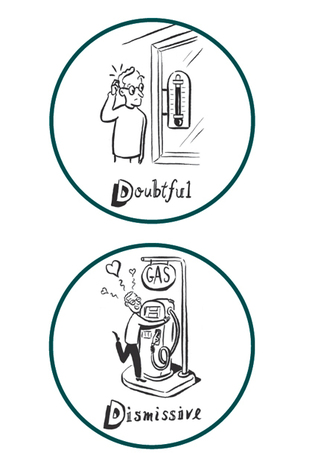
Michael Sloan
View full image
The shifting percentages of the categories, and the reasons why people change their minds, interest many scientists and environmentalists. While no one expects that a single slogan or line of argument will communicate the urgency of climate change, explains Nesbit, the Yale Project’s research could show “how we can get there sooner rather than later.”
The Yale Project generates a steady flow of reports and peer-reviewed papers to try to bring into clearer focus the shadings of public perceptions. A May 2014 report, for example, indicates that the phrase “global warming” resonates with people more than does “climate change.” Scientists and environmentalists prefer “climate change,” because it encompasses the swings predicted for extreme weather events, including snowstorms and record cold. But the survey found that men, liberals, and Generation Xers in particular responded to the term “global warming” with greater certainty that the phenomenon is happening than when it is called “climate change.”
Leiserowitz also looks at how people respond to different kinds of communication. A July 2014 paper he coauthored tested public awareness of the fact that 97 percent of climatologists have concluded that global warming is happening and is driven largely by humans’ use of fossil fuels. The finding: only one in ten Americans knew of the scientific consensus. The researchers then conducted experiments to find out what kind of message most effectively conveyed the overwhelming consensus—metaphor, descriptive text, or pie charts. The pie chart, they found, was especially effective with all groups, especially Republicans. The paper concluded: “These results suggest it is possible to improve public understanding of the scientific consensus on climate change in a way that does not trigger political polarization. In particular, our findings suggest that scientists, NGOs [nonprofit organizations], and policy makers should communicate the scientific consensus using short, simple declarative sentences or simple pie charts. Ultimately, better communication of the scientific consensus on human-caused climate change can contribute to improved public understanding and engagement with the issue.”
Some of this messaging research has drawn criticism from other academics. Dan Kahan is a professor of law and psychology at the Yale Law School who studies risk perception. “It is a mistake,” he argues, “to think that a ‘scientific-consensus social marketing campaign’ responds to the source of public conflict on this issue.” He adds that climate advocates’ social marketing can be partisan and antagonizing.
Kahan and some other social scientists contend that people tend to interpret risk based on their social “tribe”—liberal, conservative, free-market, communitarian. It’s a phenomenon he calls “cultural cognition,” and what it implies, he says, is that doling out more information will not help sway the public toward greater acceptance of climate change. Rather, people will selectively “credit or dismiss evidence of risk” depending on personal filters of ideology, faith, and biases that are tied up with their cultural identities. Kahan says his disagreement is not with Leiserowitz’s research as much as it is with those who interpret that research to mean that the right slogan will change public opinion.
“What accounts for people’s positions is something other than what they know,” Kahan says. “The question isn’t whether they know what’s going on. There is something that interferes with their receptivity to the issue.”
Leiserowitz gets it. He knows that for a long time scientists and environmentalists thought if you just gave people more information, then they would understand that climate change is the crisis of our times. That didn’t happen. Still, his research has shown that certain kinds of information, delivered to a specific audience a certain way or by trusted messengers, matters. “My bottom line is that information is necessary but it’s not sufficient.”
He believes that the relatively rapid cultural acceptance of gay people and same-sex marriage offers some hope. For a long time, gay people evoked feelings such as outrage and disgust among some Americans, he notes—“very strong feelings to overcome.” But proximity helped change those feelings, as more straight people realized that some close family and friends were gay. Similarly, it will help if people come to see climate change as something in their own backyard—not a phenomenon that will affect only polar bears or faraway countries or their great-grandchildren.
One way to drive that proximity home, the project’s research has shown, is to discuss the health effects of climate change. Global warming is expected to worsen respiratory ailments such as asthma and widen or change the territory of certain diseases carried by insects: mosquito-borne dengue fever, for instance, may move from the Caribbean to Florida. Such information engaged the Cautious in the middle without alienating the Doubtful, Leiserowitz says.
Finding the right messengers helps. Leiserowitz believes weather forecasters, for instance, are well positioned to communicate the effects of climate change. They are part of many people’s daily lives, and they’re trusted community figures. Some weathercasters deny climate science—but hundreds of others surveyed by George Mason and the Yale Project have said they would like to discuss global warming more often but lack the materials or expertise. The researchers are now providing climate change information to television weathercasters.
Adam Clark of KBJR in Duluth took a free seminar in Minnesota because he had been “on the fence” about climate change in graduate school and appreciated the chance to hear what climatologists said. The seminar convinced him that climate change was happening, he says, and gave him the resources to talk about it during his broadcasts. As the weather gets stranger, he gets more questions from viewers; he was able to explain, for instance, last winter’s polar vortex—how a shift in the jet stream, possibly due to climate change, brought brutal Arctic cold farther south. He hasn’t gotten any negative feedback, and he believes that’s because the seminar helped him shape his message. “Having a current idea of public opinion is really beneficial to understanding how best to relay that message. Do I need to sugarcoat a bit more, or can I say, ‘This is awful?’ If you go all doom and gloom, people lose hope, and then they’re like, ‘There’s nothing you can do.’ And you definitely don’t want to do that.”
It’s all about understanding your target audience’s worldview, Leiserowitz might say. At the September comedy panel, he described how the Sierra Club of Georgia and the Atlanta Tea Party teamed up to quash the state utility’s campaign against residential solar power. “Why? Because the Sierra Club cared about climate change,” he said. “The Tea Party didn’t care about climate change, but they cared a lot about consumer choice and individual freedom and your own right to be self-reliant. There are occasions when you can get the strangest of bedfellows to work together.”
“It’s almost like a rebranding of the problem,” Albanese said, “if you sell solar power or wind energy as the libertarian right to screw over the Man.”
“Windmills and guns,” said Lizz Winstead, another panelist and cocreator of The Daily Show.
“Yeah, windmills and guns, whatever it takes,” Albanese said. “People need to find their own rationale to make the changes.”
https://www.yalealumnimagazine.com/articles/4018/what-do-americans-think-about-global-warming







No comments:
Post a Comment